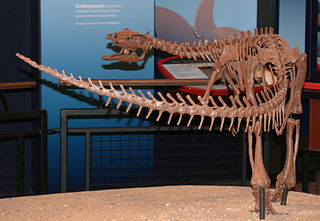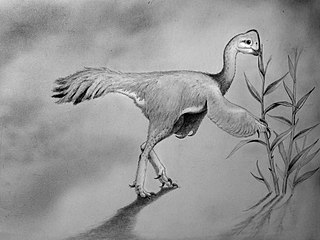
Triceratops is a genus of chasmosaurine ceratopsian dinosaur that lived during the late Maastrichtian age of the Late Cretaceous period, about 68 to 66 million years ago in what is now western North America. It was one of the last-known non-avian dinosaurs and lived until the Cretaceous–Paleogene extinction event 66 million years ago. The name Triceratops, which means 'three-horned face', is derived from the Greek words trí- meaning 'three', kéras meaning 'horn', and ṓps meaning 'face'.

Torosaurus is a genus of herbivorous chasmosaurine ceratopsian dinosaur that lived during the late Maastrichtian age of the Late Cretaceous period, between 68 and 66 million years ago, though it is possible that the species range might extend to as far back as 69 million years ago. Fossils have been discovered across the Western Interior of North America, from as far north as Saskatchewan to as far south as Texas.

Pachycephalosaurus is a genus of pachycephalosaurid ornithischian dinosaur. The type species, P. wyomingensis, is the only known species, but some researchers argue that Stygimoloch might be a second species, P. spinifer, or a juvenile specimen of P. wyomingensis. It lived during the Maastrichtian age of the Late Cretaceous period in what is now western North America. Remains have been excavated in Montana, South Dakota, Wyoming, and Alberta. The species is known mainly from a single skull, plus a few extremely thick skull roofs. More complete fossils would come to be found in the following years.

Pachyrhinosaurus is an extinct genus of centrosaurine ceratopsid dinosaur from the Late Cretaceous period of North America. The first examples were discovered by Charles M. Sternberg in Alberta, Canada, in 1946, and named in 1950. Over a dozen partial skulls and a large assortment of other fossils from various species have been found in Alberta and Alaska. A great number were not available for study until the 1980s, resulting in a relatively recent increase of interest in Pachyrhinosaurus.

Stegoceras is a genus of pachycephalosaurid (dome-headed) dinosaur that lived in what is now North America during the Late Cretaceous period, about 77.5 to 74 million years ago (mya). The first specimens from Alberta, Canada, were described in 1902, and the type species Stegoceras validum was based on these remains. The generic name means "horn roof", and the specific name means "strong". Several other species have been placed in the genus over the years, but these have since been moved to other genera or deemed junior synonyms. Currently only S. validum and S. novomexicanum, named in 2011 from fossils found in New Mexico, remain. The validity of the latter species has also been debated.

Thescelosaurus was a genus of neornithischian dinosaur that appeared at the very end of the Late Cretaceous period in North America. It was a member of the last dinosaurian fauna before the Cretaceous–Paleogene extinction event around 66 million years ago. The preservation and completeness of many of its specimens indicate that it may have preferred to live near streams.

Leptoceratops is a genus of leptoceratopsid ceratopsian dinosaur from the Late Cretaceous of North America. First found in Alberta in 1910, the type species Leptoceratops gracilis was named in 1914 by Barnum Brown for a partial skull and skeleton of two individuals found in the Scollard Formation. Additional specimens found in the Scollard include a fully complete skeleton and two other very complete individuals alongside it, uncovered in 1947 by Charles M. Sternberg. Specimens from Montana that were among some of the earliest material referred to Leptoceratops have since been moved to their own genera Montanoceratops and Cerasinops, while new material including bonebed remains from the Hell Creek Formation of Montana, and a partial skeleton from the Lance Formation of Wyoming, have been referred to L. gracilis. Combined, Leptoceratops is known from more than ten individuals all from the Maastrichtian deposits of Alberta, Montana and Wyoming, with the complete skeleton represented.

The Hell Creek Formation is an intensively studied division of mostly Upper Cretaceous and some lower Paleocene rocks in North America, named for exposures studied along Hell Creek, near Jordan, Montana. The formation stretches over portions of Montana, North Dakota, South Dakota, and Wyoming. In Montana, the Hell Creek Formation overlies the Fox Hills Formation. The site of Pompeys Pillar National Monument is a small isolated section of the Hell Creek Formation. In 1966, the Hell Creek Fossil Area was designated as a National Natural Landmark by the National Park Service.

Sphaerotholus is a genus of pachycephalosaurid dinosaur from the Upper Cretaceous of the western United States and Canada. To date, five species have been described: the type species, S. goodwini, from the Den-na-zin Member of the Kirtland Formation of San Juan County, New Mexico, USA; S. buchholtzae, from the Hell Creek Formation of western Carter County, Montana, USA and the Frenchman Formation of Saskatchewan, Canada; S. edmontonensis, from the Horseshoe Canyon Formation of Alberta, Canada; S. lyonsi, from the Dinosaur Park Formation (Campanian) of Alberta, Canada; and S. triregnum from the Hell Creek Formation of Garfield County, Montana, USA.

Edmontosaurus annectens, often colloquially and historically known as Anatosaurus, is a species of flat-headed saurolophine hadrosaurid dinosaur from the late Maastrichtian age at the very end of the Cretaceous period, in what is now western North America. Remains of E. annectens have been preserved in the Frenchman, Hell Creek, and Lance Formations. All of these formations are dated to the late Maastrichtian age of the Late Cretaceous period, which represents the last three million years before the extinction of the non-avian dinosaurs. E. annectens is also found in the Laramie Formation, and magnetostratigraphy suggests an age of 69–68 Ma for the Laramie Formation. Edmontosaurus annectens is known from numerous specimens, including at least twenty partial to complete skulls, discovered in the U.S. states of Montana, South Dakota, North Dakota, Wyoming, and Colorado, as well as the Canadian province of Saskatchewan. It had an extremely long and low skull, and was quite a large animal, growing up to approximately 12 metres (39 ft) in length and 5.6 metric tons in average asymptotic body mass, although it could have been even larger. E. annectens exhibits one of the most striking examples of the "duckbill" snout that is common to hadrosaurs. It has a long taxonomic history, and specimens have at times been classified as Diclonius, Trachodon, Hadrosaurus, Claosaurus, Thespesius, Anatosaurus, and Anatotitan before all being grouped together in Edmontosaurus.
Paleopsephurus is an extinct genus of paddlefish (Polyodontidae). At present the genus contains the single species Paleopsephurus wilsoni. The genus is known from the Late Cretaceous (Maastrichtian) aged Hell Creek Formation of Montana.
This is an overview of the fossil flora and fauna of the Maastrichtian-Danian Hell Creek Formation.

Tatankaceratops is a controversial genus of herbivorous ceratopsian dinosaur. It is a small chasmosaurine ceratopsian which lived during the Late Cretaceous period in what is now South Dakota. It is known from a single partial skull which was collected from the Hell Creek Formation, dating to 66 million years ago. Tatankaceratops was described by Christopher J. Ott and Peter L. Larson in 2010 and the type species is Tatankaceratops sacrisonorum. Tatankaceratops is known from one specimen housed at the Black Hills Institute, BHI 6226.
Gilmoremys is an extinct genus of softshell turtle which lived during the late Cretaceous of North Dakota, Montana and Wyoming, United States.

Xenoceratops is a genus of centrosaurine ceratopsid dinosaur known from the Late Cretaceous, and is known to have lived in what is currently Alberta, Canada. The genus has one known species, Xenoceratops foremostensis. Its remains were discovered in the Foremost Formation.

Acrotholus is an extinct genus of pachycephalosaur dinosaur that lived during the Santonian of the late Cretaceous, in the Milk River Formation of Canada. The type species, A. audeti, was named after Roy Audet allowing access to his ranch leading to the discovery of the species. The discovery of this specimen lead to several new revelations in the fossil records questioning the preservation of small-bodied organisms along with the evolution of early pachycephalosaurs. The iconic cranial dome found on Acrotholus makes it one of the earliest indisputable known members of the pachycephalosaur family.
Sphaerium beckmani is an extinct species of fossil freshwater pea clams from the Late Cretaceous deposits of North America. This species was first described by the American paleontologist Loris Shano Russell in 1976. The specimens were collected by the American paleontologist Karl M. Waage from 1961 to 1962 from the Hell Creek Formation of eastern Montana. The locality is dated to the late Maastrichtian Age.

Acheroraptor is an extinct genus of dromaeosaurid theropod dinosaur known from the latest Maastrichtian Hell Creek Formation of Montana, United States. It contains a single species, Acheroraptor temertyorum. A. temertyorum is one of the two geologically youngest known species of dromaeosaurids, the other being Dakotaraptor steini, which is also known from Hell Creek. A basal cousin of Velociraptor, Acheroraptor is known from upper and lower jaw material.

Leptorhynchos is an extinct genus of caenagnathid theropod from the Late Cretaceous of what is now the US state of Texas, although it has been suggested to also exist in Alberta and South Dakota. The type species is L. gaddisi, and it is currently the only widely accepted valid species. The generic name of Leptorhynchos comes from the Greek "leptos" meaning "small" and "rhynchos" meaning "beak". The specific epithet is in honor of the Gaddis family, who owned the land on which the holotype was discovered.



















